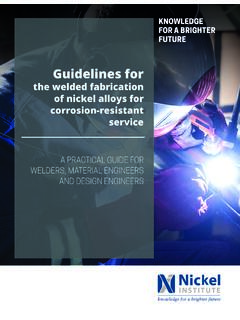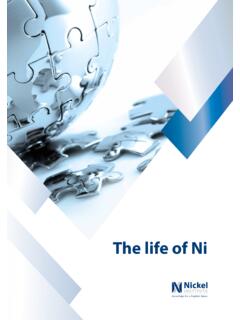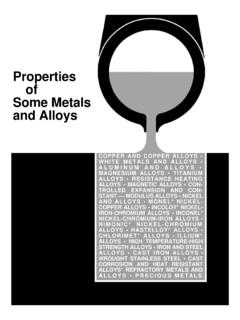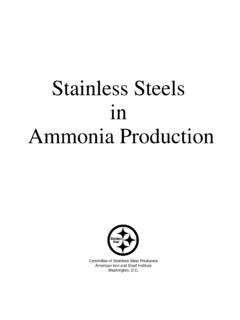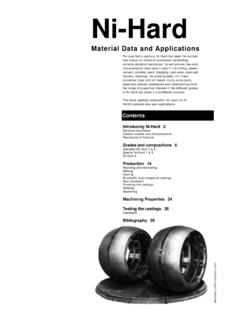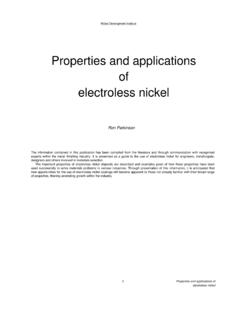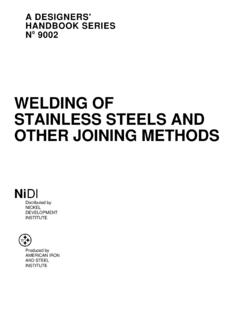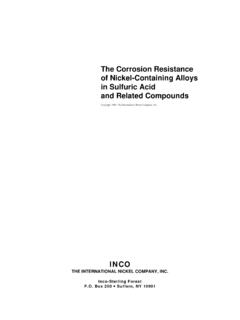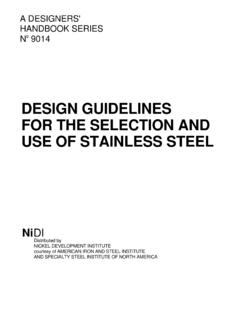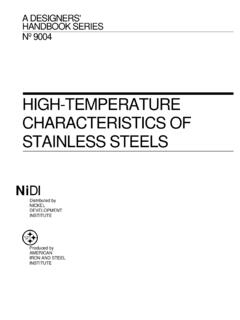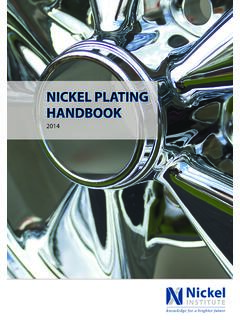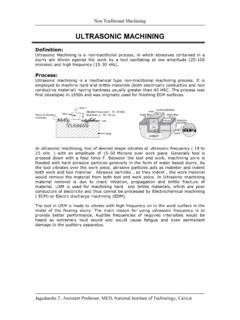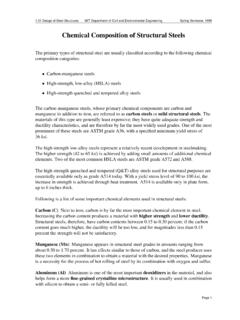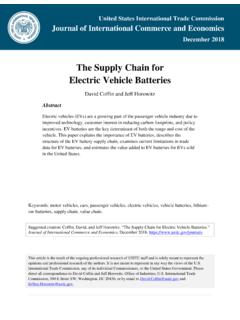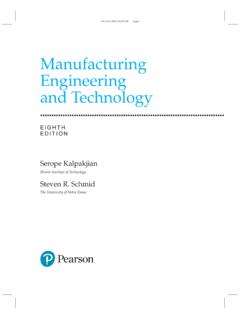Transcription of NiDI - Nickel Institute
1 Pay attention to dissimilar -metal welds Guidelines for welding dissimilar metals Reprinted with permission from Chemical Engineering Progress May 1991 1991 American Institute of Chemical Engineers All rights reserved NiDINICKEL DEVELOPMENT INSTITUTENiDI Reprint Series NO 14 018 Richard E. Avery The material presented in this publication has been prepared for the general information of the reader and should not be used or relied on for specific applications without first securing competent advice.
2 The Nickel Development Institute , its members, staff and consultants do not represent or warrant its suitability for any general or specific use and assume no liability or responsibility of any kind in connection with the information herein. 1 Pay Attention to dissimilar -Metal WeldsRecent experience with boiler tubing reveals how welding practices affect weld joint performance in service. Richard E. Avery, Avery Consulting Associates, Inc. issimilar-metal weldingrefers to the joining of two different alloy systems.
3 Actually all fusion welds are dissimilar -metal welds (DMWs) because the metals being joined have a wrought structure and the welds have a cast structure. Frequently the match-ing-composition filler metal is deliberately altered from that of the base alloys. For this discussion a dissimilar -metal weld will be that between metals of two different alloy systems. On this matter, the chemical process industries can learn something from the power industry.
4 A very common DMW ap-plication is joining ferritic [ , 2 1/4% Cr-1% Mo (UNS K21590)] tubes to austenitic boiler tubes such as 304H (S30409) or a similar austenitic stainless steel. Because these welds are so impor-tant, they are treated separately in this article. Metallugical factors In dissimilar -metal welding, the prop-erties of three metals must be considered: the two metals being joined and the filler metal used to join them.
5 For example, if one of the metals being joined is welded using preheat when welding to itself, pre-heat should be used in making a DMW. Another variable might be heat input con-trol. On occasion there may be a conflict in that the optimum control for one metal is undesirable for the other. In this case, a compromise is needed. This is one reason the development of a DMW procedure often requires more study than for a con-ventional, similar-metal welding proce-dure.
6 Fusion welds and other joining meth-ods. The processes available for joining dissimilar metals are: l. Fusion welds. The processes for fu-sion welds include shielded metal arc (SMAW), gas metal arc (GMAW), sub-merged arc (SAW), flux cored arc (FCAW), and gas tungsten arc (GTAW). With these processes there is a well-defined weld that preferably contains a substantial filler-metal addition. With the GTAW process, however, the amount of filler added is controlled by the welder.
7 The welder should be trained to make the prop-er filler-metal addition used for the partic-ular welding procedure. 2. Low-dilution welds. Low-dilution welds include electron beam, laser, and pulsed arc; the amount of base metal melt-ed is relatively small, and filler metals are not normally added. 3. Nonfusion joining: Typical nonfusion joining processes are friction welding, and explosion welding, diffusion bonding along with brazing and soldering. dissimilar -metal joints can usually be made by any of these methods, but low-di-lution and nonfusion joining processes are more often used for high-production, spe-cial-application joining.
8 DMWs encoun-tered in power and process industries are most often fusion welds made by the more common welding processes. In fusion welding, the weld metal is a mixture of the two metals being joined and the filler metal. In arc welds made with consumable electrode processes such as SMAW, GMAW, SAW, and FCAW, the weld metal is well mixed or stirred by the arc action and the composition is quite uni-form from one area to another. By sampling any place in the weld bead, the weld com-position is determined and weld properties reasonably predicted.
9 While the bulk of the weld is well mixed, there is an unmixed zone (UMZ) at the weld interface, which is a very narrow boundary layer of melted base metal that froze before mixing with the weld metal. Fortunately, the UMZ is seldom important in normal service envi-ronments but, on rare occasions, has ex-hibited selected corrosion attack. There is also a zone of unmelted base metal that will have been altered by the heat of welding. D 2 This heat-affected zone (HAZ) can influence service life.
10 Determining weld composition. It is necessary to know the approxi-mate weld metal composition before the service performance can be pre-dicted. Table 1 lists three methods of determining the weld metal compo-sition along with advantages and lim-itations. The technique for method 1 is obvious: metal is removed from the weld and an analysis performed. Method 2 approximates weld dilu-tion by area measurement as shown in Figure 1. Method 3 uses the fol-lowing base metal dilution percent-ages for some of the common weld-ing processes: SMAW (covered electrode): 20 to 25% dilution GMAW (spray arc): 20 to 40% dilution GTAW: 20 to 50% dilution SAW (submerged arc): 20 to 50% dilution The figures are approximate be-cause the welding technique has a strong influence on the dilution, par-ticularly with GTAW.
